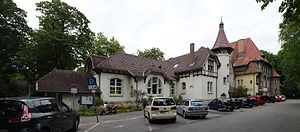Krefeld city forest
The city forest is a cultivated forest area in the middle of the city of Krefeld . It is located in the Bockum district and covers an area of 120 ha .
In the Krefeld city forest there is a very large meadow with soccer goals, a children's playground, a large, branched pond with a pedal boat rental and walking paths. The park area also features the Krefeld racecourse, one of the most beautiful German racecourses, a golf course, a hockey field and tennis courts. The Stadtwaldhaus with one of the largest beer gardens outside of Bavaria offers space outdoors for around 3,000 day trippers. The landscape park was included in 2004/2005 as an outstanding park in the street of garden art between the Rhine and the Maas .
history
The city forest can be traced back to the Krefeld silk baron Wilhelm Deuss . He gave the area of the city forest (at that time only 35 hectares in size) in 1897 as a gift to the city of Krefeld. To this end, he donated 20,000 marks to the city on the occasion of his 70th birthday with the stipulation that the city forest should be expanded, reforested and used as a recreational area for the Krefeld population. In 1901 the city released the first areas of the park, which was laid out in the style of an English landscape garden, for the citizens.
In 1907 Deuss donated a further 50,000 marks to the city to buy back the surrounding areas for expansion. In a small temple at the Stadtwaldweiher (Deuss temple) opposite the Stadtwaldhaus, a plaque commemorates this good deed. In addition, to commemorate this gesture, the closing street in the northern city forest was named "Deussstraße".
From 1901 the people of Krefeld and other excursionists in the recreation area were able to refresh and strengthen themselves in a small forest inn. The opening of the Kurhaus and restaurant on July 8, 1902 was also celebrated by the then mayor of the city Ernst Küper and Wilhelm Deuss. By 1911, the Waldschänke had been expanded into today's Stadtwaldhaus in Art Nouveau style . A music pavilion completed the beer garden. The "Kurhaus und Restaurant" was retained and was directly adjacent to the Stadtwaldhaus.
During the Second World War, the Wehrmacht misappropriated the Stadtwaldhaus and used it as a temporary barracks . After American soldiers conquered Krefeld on March 3, 1945, British soldiers moved in a little later. The Art Nouveau building probably reminded them of English aristocratic residences .
In 1958, the city officials considered redesigning the city forest house. Surprisingly, from 1959 onwards, they suddenly intended to build a new building on the site. The new town hall should stand by the pond . Proponents and opponents of the project were balanced for a long time. When the planning for the construction was completed, however, the citizens campaigned for the preservation of the original property. Experts confirmed the "rock solid structure and functionality" of the Stadtwaldhaus, so that the city council ultimately voted against the new building. However, the Stadtwaldhaus was modernized and the open arcade terraces were incorporated into the hall.
Events
Since 1996, sports enthusiasts have been meeting annually in the Krefeld Stadtwald for running , walking and handbiking at the Krefeld Whitsun Run , with the entry fee for the campaign for the disabled-friendly playgrounds .
Web links
Individual evidence
- ^ Krefeld Whitsun run accessed on May 22, 2012
Coordinates: 51 ° 21 ′ 10 ″ N , 6 ° 35 ′ 0 ″ E


